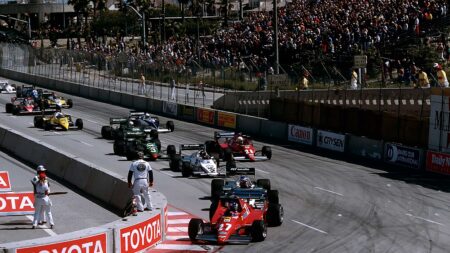
45. 1983 USA GP West: Watson takes record win from 22nd on the grid
March 27, Long Beach They lined up in close company, though, John Watson 22nd and Niki Lauda 23rd… Tambay led into the first corner as Keke Rosberg separated the Ferraris,…

Stewart follows BRM team-mate Graham Hill past the harbour during the 1965 Monaco GP, in which he finished third in his first F1 start at the track

Stewart signals from the cockpit during the very wet first practice session at Monaco in 1965. Conditions would be dry for the race, but overcast

After the race, Stewart congratulates Hill on his third straight Monaco GP victory, achieved despite an early trip down an escape road

The Monaco Grand Prix, Monte Carlo, June 3, 1973. Jackie Stewart with his Tyrrell 006 at the old Station Hairpin on his way to a big win. (Photo by Klemantaski Collection/Getty Images)

Continuing problems with BRM’s 3-litre H16 engine caused the team to revert several times to its older 2.0 V8 in 1966, including here at the Nürburgring. It was powerful enough to get the car off the ground, but Stewart finished a distant fifth

Stewart and wife Helen looking cheerful in the paddock at Brands Hatch’s second British Grand Prix, in 1966

He qualified his BRM P261 eighth before posting an early retirement when its engine failed

The BRM P261s of Graham Hill and Jackie Stewart thread into Parabolica at Monza in 1965. They duelled for the lead with John Surtees and Jim Clark, but clutch and fuel pump problems eventually sidelined the opposition and Stewart went on
to beat his team-mate

Nine months after his maiden F1 start, with Lotus in the non-championship 1964 Rand GP, Jackie Stewart becomes a winner at the sport’s top table, taking the chequered flag at Monza

celebrating in the race’s immediate aftermath

The 1968 season was Stewart’s first in F1 with his former F3 entrant Ken Tyrrell. He missed a couple of GPs because of a broken scaphoid, sustained in an F2 race at Jarama, but bounced back to take his Matra to three wins, the first of them here in Holland

Stewart in contemplative mood at Monza in 1967, towards the end of his three-season stint with BRM. As was so often the case that year, he retired when the car let him down – engine failure, in this instance

Podium celebrations following Stewart’s victory in the 1968 Dutch GP at Zandvoort. It was the third world championship F1 success of his career, a first with Ken Tyrrell and also his first since Monaco in 1966

Stewart leads away at the start of the 1970 South African GP, after qualifying F1 newcomer March’s 701 chassis on pole. He finished third, but the disadvantages of running a customer car would set Tyrrell on the road to becoming a constructor

Stewart in conversation with Denny Hulme during the 1967 season, when the New Zealander became his nation’s first – and to date only – world champion. Stewart recorded just two finishes during the course of that campaign, though he was on the podium both times

Stewart waits to be unleashed ahead of the 1969 Dutch GP at Zandvoort. High-mounted rear aerofoils had been banned earlier in the year following a series of failures, but more modest wings, such as that on the Scot’s Matra MS80, soon began to appear

The Stewarts in jovial mood following Jackie’s hard-earned victory in the 1969 British GP at Silverstone. Jochen Rindt had run him close until one of his rear wing endplates worked loose. To the left is well-known commentator Peter Scott Russell

Champagne moment at the Circuit de Charade, in the slipstream of Stewart’s 1972 French GP victory. It was one of four such successes over the season’s course, but that was not enough to prevent 25-year-old Brazilian Emerson Fittipaldi becoming world champion

The simplicity of Formula 1 pit life in 1969. Stewart’s Matra MS80 at rest during the Dutch Grand Prix weekend, with Jochen Rindt’s Lotus 49B sitting unoccupied to the left

The 1966 Monaco GP was the first world championship race of F1’s new 3-litre era… and Stewart won comfortably with a 2.0-litre V8, as BRM’s complex 3.0 H16 wasn’t yet fully ready. Only four cars were classified as finishers at the end of 100 laps

A charming snapshot from an era when racing drivers were a band of brothers, capable simultaneously of both rivalry and close friendship. Graham Hill was the established lead driver at BRM, having taken the team’s only world title in 1962, but by 1966 Stewart was at the forefront
of the next generation
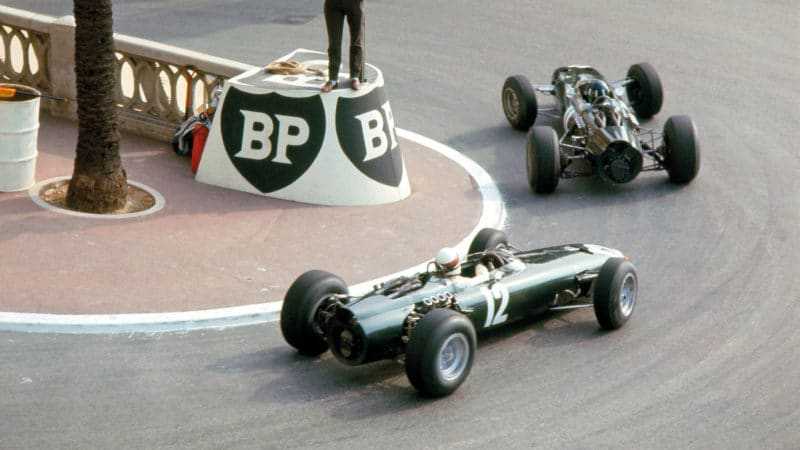
Who needs crash barriers? Driving updated versions of BRM’s P261, Graham Hill and Jackie Stewart file through what was then known as the Station Hairpin during the 1966 Monaco GP. Winner of the race for the previous three seasons, Hill finished more than a lap behind his team-mate in third place

After more than two and a half hours at the wheel, Stewart completes his 1966 Monaco GP victory, passing the flag brandished by local hero Louis Chiron (winner of the same race 35 years beforehand and the first Monegasque to accomplish the feat).

The Stewarts showcase the art of casual celebration
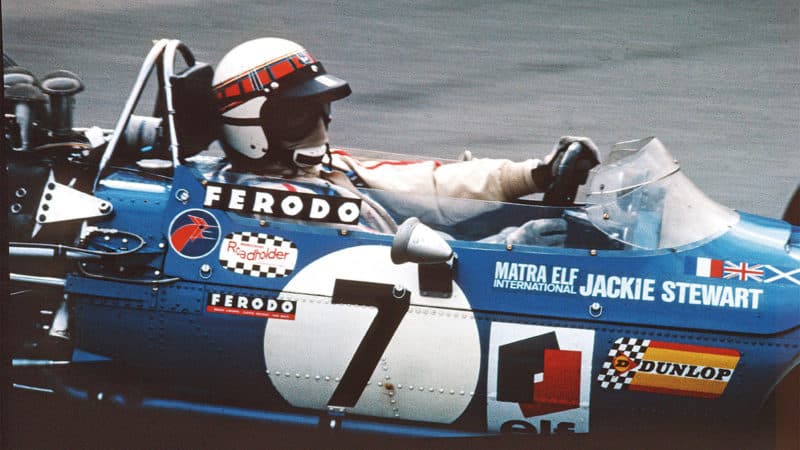
In 1968 Stewart was on course to take what would have been his only F1 victory at Spa… until his Matra ran out of fuel with a lap to go. He was eventually classified fourth. Although highly critical of circuits he considered dangerous – such as Spa and the Nürburgring – he was quick at both

After a successful start to his 1969 world championship campaign in South Africa, Stewart was on top again at Montjuïc Park, Spain. He won by two clear laps, but had inherited the lead when a seized engine denied Ferrari driver Chris Amon a likely victory

Having taken pole position by 1.8sec, Stewart went on to score a comfortable win in the 1969 French GP, beating Matra team-mate Jean-Pierre Beltoise by almost a minute. The race had a field of only 13 cars

Stewart in action at the Österreichring during the 1971 Austrian GP. Having qualified second to Jo Siffert’s BRM, he was running third in the race when a left-rear stub axle failure caused him to leave the road. With closest title rival Jacky Ickx also retiring, however, Stewart’s second world title was secure by the afternoon’s end

Stewart takes his third victory of the 1968 world championship campaign, greeted by the perennially flamboyant Watkins Glen flag-waver Tex Hopkins. American Mario Andretti buoyed his home crowd by taking pole, but Stewart led all the way

Stewart in the Watkins Glen paddock in 1968

Looking completely at home in the Matra MS10, en route to a straightforward win

The Stewart clan in the pits at Monza in 1969, with Helen and Jackie joined by young sons Paul (on the left, cradling a stopwatch) and Mark. Paul went on to race at a high level and got as far as testing F1 cars, but never started a grand prix

Stewart wasn’t just celebrating his latest race victory after his success that afternoon at Monza, for he had also clinched his maiden world championship title with three races of the season still to run

Stewart leads Jochen Rindt, Graham Hill, Piers Courage, Jean-Pierre Beltoise and Bruce McLaren during the 1969 Italian GP, a classic Monza slipstreamer. By the end of the race the top four were covered by just 0.19sec, with Stewart ahead

Stewart on pole at Monaco in 1971, before a victory he considers to have been one of his finest. His rear brakes failed shortly before the start and, as there was no chance to address the problem, he just simply had to cope without them

Stewart with the spoils of success after the 1971 French GP, which took place for the first time at the Circuit Paul Ricard. Situated in Le Castellet, southern France, the venue took its name from a local pastis magnate who helped finance its construction

Tyrrell’s promise as a manufacturer was obvious from the moment Stewart took pole on the marque’s world championship debut in the 1970 Canadian GP. By the second race of the following season, in Spain, it was a winner

Stewart steers through the aftermath of an accident involving Jackie Oliver and Jacky Ickx in the 1970 Spanish GP. His win would be the last in F1 for a customer chassis run by a private team

Stewart strapped into Tyrrell 003 at Paul Ricard in 1971. The safety standards of the day might look primitive, but at the time were thought to be at the cutting edge of driver protection

Post-race celebrations at Monaco in 1971, in the company of Prince Rainier and Princess Grace (Grace Kelly –the former American film star). Stewart scored three of his 27 world championship victories in Monaco, the first in 1966 and the last in ’73

Stewart nurses Tyrrell 003 around the principality’s streets in 1971. Despite not having rear brakes, he won by 25.6sec from Ronnie Peterson (March 711) and Jacky Ickx (Ferrari 312 B2). Denny Hulme (McLaren M19A) was the only other driver to complete the full 80 laps

Stewart’s expression says it all after a dominant performance in the 1971 British GP. He started second to Clay Regazzoni, but soon took the lead and then pulled away. He scored both his British GP wins at Silverstone; his best result at Brands Hatch was second, in 1972

Following wins in Spain and Monaco earlier in the campaign, Stewart put together a run of three mid-season victories to underline his status as 1971 championship favourite – the second of those coming on home soil at Silverstone

Still wearing an open-face crash helmet, Stewart prepares to take the start at the 1969 German GP. Full-face helmets had made their first appearance at the same venue one year earlier, courtesy of Dan Gurney; Stewart would soon follow his lead

Stewart and Chris Amon tear away from the front row at Monaco in 1971. Their careers ran in parallel for many years, but Stewart scored 27 wins from 99 GP starts and Amon – ever fast but unlucky – none from 96

Stewart put his Matra MS80 on pole position by 0.4sec ahead of the 1969 Monaco GP, but a broken driveshaft condemned him to retirement after only 22 of the scheduled 80 laps; nine of the 16 starters dropped out

Stewart and Jacky Ickx engage in a lively discussion ahead of the 1970 Monaco GP, from which both drivers retired

Tunnel vision: Stewart looked to be completely in control at Monaco in 1969, but he and Matra team-mate Jean-Pierre Beltoise suffered identical failures within moments of each other

Armed with corduroy cap and oversized shades, Stewart looks composed amid the hustle and bustle on the grid at Monaco in 1971

The combined forces of Tyrrell and Goodyear line up for a team photo at Monza in 1971, with team-mates Stewart and Cevert occupying a wheel apiece… and the boss facing the wrong way

Stewart made a flying start as he began his title defence in the 1972 Argentine GP, but a stomach ulcer interrupted his campaign. He was forced to miss the Belgian GP and eventually finished second to Emerson Fittipaldi in the standings

Tyrrell team-mates Jackie Stewart and François Cevert soak up the plaudits after taking first and second in the 1973 Belgian GP at Zolder

Stewart and Cevert in the limelight once more, this time after taking their Tyrrells to first and second places in the 1971 German GP at the Nürburgring, one of two occasions during the year in which they swept to the top two positions

Stewart at the Nürburgring in 1971. He was aware of the track’s dangers, yet often its master
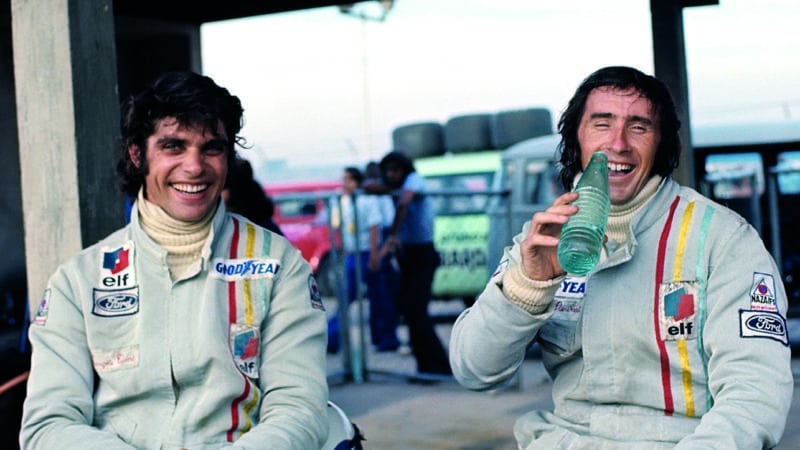
Cevert and Stewart in high spirits before the 1973 Dutch GP at Zandvoort. Stewart would take a record-breaking 26th career win, with the Frenchman second, but the post-race mood was sombre. The race was marred by an accident that killed rising British star Roger Williamson

all smiles at Kyalami after victory in the 1973 South African GP
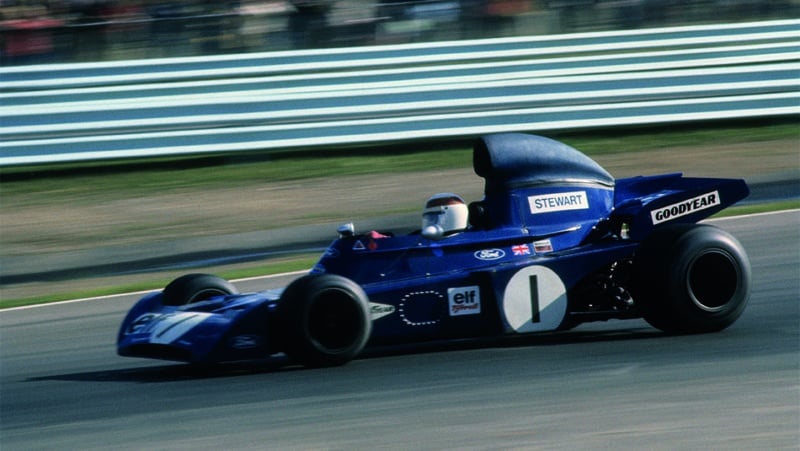
Stewart captured at speed during the 1972 US GP. He was scheduled to make his 100th and final GP start at the same venue one year later, but Cevert’s death in practice would prompt the team to withdraw

Jackie and Helen Stewart on the podium at Watkins Glen in 1972, the Scot having ended his campaign as he’d started it, with a victory. He started on pole and finished more than half a minute clear of team-mate Cevert

Stewart and Tyrrell designer Derek Gardner at Anderstorp in 1973, when fading rear brakes cost him any chance of a podium finish in the first world championship Swedish GP

Stewart won the Monaco GP for a third time in 1973, taking a 25th world championship F1 victory that put him level with fellow Scot Jim Clark at the top of the list of all-time winners. Having taken pole position on a significantly revised track, he took a narrow victory over main title rival Emerson Fittipaldi

Helen Stewart joins her husband for post-race festivities, unaware that he’d already made up his mind to retire at the year’s end. As he later explained, he wanted to break the news once he’d completed his final event rather than have her counting off races one by one at a time when the sport remained very perilous

Ken Tyrrell and Stewart confer in the immediate post-race hubbub at the 1973 German GP, where the Scot had recorded what turned out to be his final F1 victory